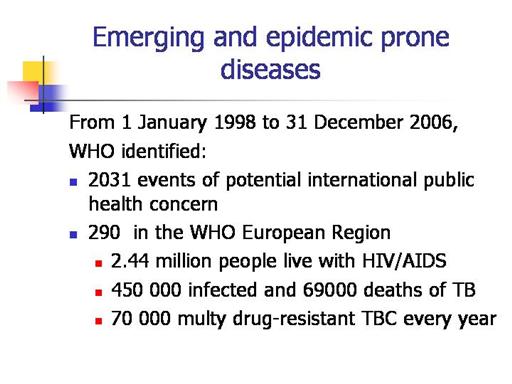| front |1 |2 |3 |4 |5 |6 |7 |8 |9 |10 |11 |12 |13 |14 |15 |16 |17 |18 |19 |20 |21 |22 |23 |24 |25 |26 |27 |28 |29 |30 |31 |32 |33 |34 |review |
 |
The world faces:
•- the emergence of new or newly recognized pathogens, such as the viruses
causing severe acute respiratory
syndrome (SARS) and avian
influenza;
•- the recurrence of well-characterized outbreak-prone diseases: cholera,
dengue, influenza, poliomyelitis, measles,
meningitis, shigellosis and
yellow fever; and
•- the accidental or deliberate release of biological agents (anthrax, prion
diseases such as variant Creutzfeldt-Jakob
disease - vCJD)
By the end of 2006, 2.44
million people were estimated to be living with HIV/AIDS in the 53
countries in the WHO European Region, most of them in eastern Europe and
central Asia.
Every year, 69 000 people in
the European Region die of tuberculosis (TB) and 450 000 people become
infected. In eastern Europe, poor TB control practices result in nearly
70 000 cases of multidrug-resistant TB (MDR-TB) every year: the highest
rate in the world. About half of these cases are resistant to all
first-line anti-TB drugs. Some strains are also resistant to second-line
drugs: so-called extensively drug-resistant TB (MDR-TB).
MDR-TB is reported to be
increasing in eastern Europe, and causes concern about a future epidemic
of virtually untreatable TB.
Poliomyelitis has been
eradicated from the Region, and measles is targeted for elimination.
This brings obvious benefits, but also exposes countries to risks,
including the potential reintroduction of disease from an external
source or the intentional release of pathogens. To achieve and maintain
disease elimination or eradication, strong public health capacity in
surveillance is required at the national and international levels.
|